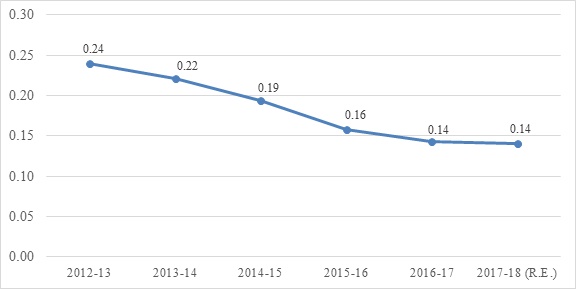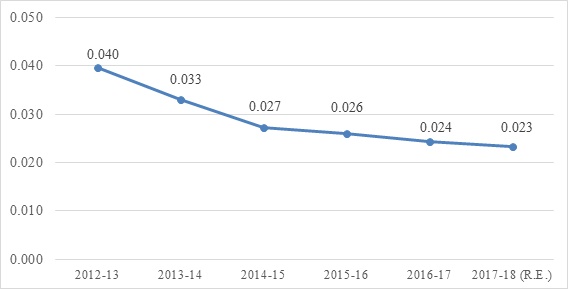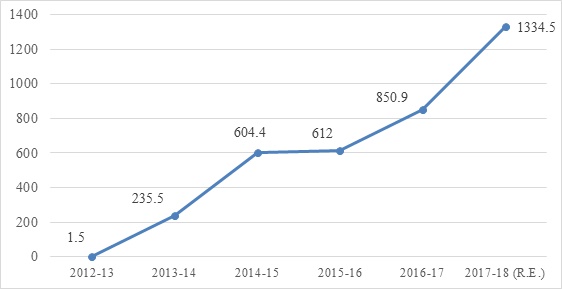Given the threat of jobs displacement on account of the rise of automation and artificial intelligence, it has become crucial to develop a high-quality labour force with advanced cognitive skills. In this context, Raavi Aggarwal examines the trends in government spending on the education sector, as well as learning outcomes. She contends that in order to sufficiently prepare for the Fourth Industrial Revolution, we need to make adequate investments in education, skills, and innovative capacity now.
The rise of artificial intelligence, enabled by big data and machine learning, potentially redefines what constitutes ‘human activity’. With robots replicating not only manual tasks but also non-routine cognitive ones, it has become crucial to invest in education, skills training, and capacity for innovation, to mitigate the threat of jobs displacement. In this context, designing and implementing effective government policies to impart quality education and skills at the primary, secondary, and tertiary levels is pertinent. Education should first build children’s key skills such as reading and arithmetic, which are necessary for higher learning, and then focus on developing their analytical abilities to ensure a highly skilled labour pool that can either complement or compete with advanced technologies.
I examine India’s preparedness for the Fourth Industrial Revolution by analysing students’ learning outcomes over the last five years (2012-13 to 2017-18), as well as the adequacy of the government’s budgetary allocations for the education sector.
Elementary education
The Right of Children to Free and Compulsory Education Act (RTE), 2009, aims to ensure free access to education for all children in the 6-14 age group, within a framework of collaboration between the Centre and state governments, piloted largely through the Sarva Shiksha Abhiyan1 (SSA). India’s low public expenditure on education in proportion to its GDP (gross domestic product), hovering at around 3% per annum over the last decade, has been well documented in the policy literature (Centre for Budget and Governance Accountability (CBGA) and United Nations Children's Fund (UNICEF), 2011). Within the total education budget, expenditure on SSA stands at less than 1% of GDP. Figure 1 shows a gradual decline in the expenditure on SSA, as a % of GDP, from 0.24% in 2012-13 to 0.14% in 2017-18 (revised estimates or R.E.2).
Figure 1. Expenditure on Sarva Shiksha Abhiyan (as % of GDP), 2012-13 – 2017-18
The second part of the story pertains to learning outcomes in schools. According to ASER (Annual Status of Education Report), while student enrolment in schools has consistently exceeded 95% since 2008, learning levels have witnessed only a modest improvement and have even deteriorated in some aspects. In 2016, 43% of Class 8 students could solve both subtraction and division problems, whereas 23% could only do subtraction. In terms of reading ability at the Class 2 level, while the percentage of Class 2 pupils who could accurately read the given text improved from 9% in 2010 to 13% in 2016, the corresponding figure for Class 8 pupils deteriorated from 83% in 2010 to 73% in 2016. This reflects a worsening in the quality of education being imparted or systemic defects in the education system.
The National Achievement Survey (NAS), conducted by the NCERT (National Council of Educational Research and Training), assesses students on similar metrics and found that in 2014, 65% of Class 3 students could perform subtraction and 57% could perform division. However, the corresponding figures from ASER showed that 18% of Class 3 students could perform subtraction and only 7% subtraction and division both. Evidently, the numbers reported by NAS are significantly higher than those of ASER. However, a number of differences exist in the two survey instruments that could lead to such contrasting results. Firstly, while ASER surveys rural areas only, NAS covers both rural and urban areas. Secondly, while NAS surveys students in government and aided schools, ASER surveys both children enrolled in school and those out of school in the relevant age group (Banerjee 2018). These differences in methodologies preclude a comparison of ASER and NAS and point to a need for both datasets to be reconciled in order to depict a complete picture of educational outcomes in the country at the elementary level.
Secondary education
While the SSA is limited to primary education, the Rashtriya Madhyamik Shiksha Abhiyan (RMSA) has been implemented to improve the quality of secondary education in public schools in India. I look at budget expenditures for the scheme over the last five years. Although in absolute terms the expenditure has been stable, with a small net decline from Rs. 39.49 billion in 2012-13 to Rs. 39.15 billion in 2017-18 (R.E.), as a proportion of GDP, it has almost halved over this period. ASER (2017) presents statistics on learning outcomes for youth in the 14-18 age group, based on surveys conducted in 26 rural districts across 24 states. The survey showed that 23% of youth could not read a Class 2 level text and 77% could not perform division problems, a reflection of poor learning outcomes at the secondary school level. The persistence of learning deficits from the primary to the secondary school level indicates that students are not assimilating concepts that are necessary for higher education and technical skills, which in turn are vital to face the challenge of the changing nature of work.
Figure 2. Expenditure on Rashtriya Madhyamik Shiksha Abhiyan (% of GDP), 2012-13 – 2017-18
In a more digital world, imparting digital literacy to both the current and next generation of workers assumes importance. Advancements in internet infrastructure and incorporation of technology such as computers and interactive systems in classrooms can help attenuate the gap between theoretical concepts learned in schools and skills utilised in firms (Asian Development Bank (ADB), 2018). This further needs to be complemented by a change in pedagogy that focuses on developing critical thinking and analytical skills. In turn, this will enhance students’ ability to apply concepts in practice and facilitate the development of non-routine skills. As automation gradually displaces workers in routine tasks, socio-emotional and
To facilitate the use of Information and Communications Technology (ICT) in schools and encourage open and distance learning, the government launched the National Mission on Education through
Adult education
A key component of school education pertains to adult education at the elementary school level. This is an important initiative in the context of the future of work, which requires significant retraining of older and experienced workers to adapt their
Higher education
Labour economic theory postulates that an individual’s earnings depend significantly on their years of schooling and potential years of work experience. Empirical analysis of this ‘Mincer earnings equation’ suggests an increase in the relative demand for highly educated workers, beginning in the 1970s, owing to skill-biased technological change. This implies that workers with a college degree had an advantage over those with a high school diploma in procuring a job. This has further accentuated the wage gap between high school and university educated workers, leading to the wage polarisation observed today (Lemieux 2006). This implies a pressing need to augment enrolment and learning outcomes at the higher education level, particularly in the context of polarisation of jobs and wages due to rising automation.
Here, I explore the budgetary allocation for the higher education sector by analysing the expenditure incurred by the University Grants Commission (UGC). The analysis is restricted to expenditure on the UGC as the bundling of various higher educational schemes across budget documents has limited comparability across years. Expenditure undertaken by the UGC has declined substantially from Rs. 96.78 billion in 2012-13 to Rs. 49.23 billion in 2017-18 (R.E.). As a percentage of GDP, this has translated into a drop from 0.1% in 2012-13 to an abysmal 0.03% in 2017-18 (R.E.).
Research & development
Government expenditure on research and development (R&D), which is vital for developing the innovative capacity of a country, has risen over time to appreciable levels – from Rs. 1.5 million in 2012-13 to Rs. 1.33 billion in 2017-18 (R.E.). Major schemes in R&D include ‘Training and Research in Frontier Areas’, ‘National Initiative for Design Innovation’ and the ‘National Initiative for Technology Transfer’ or ‘Startup India’, as it is known since 2016-17.
Figure 3. R&D expenditure (in Rs. million), 2012-13 – 2017-18
Preparing for the Fourth Industrial Revolution
While innovation forms an important part of human capital, it is essential to focus on the education sector to capitalise on the potential opportunities evinced by the Fourth Industrial Revolution. In particular, investments in education at all levels of schooling must be increased and learning deficits in schools eliminated. At this juncture, it is critical for the government to act as a catalyst for effective policy intervention to prepare the youth for the future of work. While skill acquisition may be a temporary solution to the jobs crisis, it will be no substitute for high-quality education that inevitably takes years to acquire. If we make the necessary investments now, we may be prepared by the time technologies become economically viable to compete with low-cost labour, which
The author would like to thank Utkarsh Patel for valuable comments on the post.
Notes;
- SSA is Government of India’s flagship programme to achieve
universal elementary education in a time-bound manner. It has been operational since 2000-01. - While for the years 2012-13 to 2016-17 we utilise ‘Actual’ expenditure incurred, for 2017-18, we utilise the ‘Revised Estimates’ available in the Union Budget documents. The ‘Actual’ expenditure is the final amount spent on a scheme and is assessed at the end of a financial year. In contrast, ‘Revised Estimates’ reflect the supplementary expenditure on a scheme, over and above the budget allocation at the beginning of the financial year.
Further Reading
- ADB (2018), ‘Asian Development Outlook (ADO) 2018: How Technology Affects Jobs’, Asian Development Bank, April 2018.
- Banerjee, R (2018), ‘Three milestones in education’, The Hindu, 30 January 2018.
- CBGA and UNICEF (2011), ‘Sarva Shiksha Abhiyan (SSA): Budgeting for Change Series, 2011’, December 2011.
- Lemieux, T (2006), ‘The “Mincer Equation” Thirty Years After Schooling, Experience, and Earnings’, in S Grossbard (ed.), Jacob Mincer A Pioneer of Modern Labor Economics, Springer, Boston, MA.




 13 August, 2018
13 August, 2018 







By: Shubham Sharma 14 August, 2018
The article vindicates the Economists Automation Readiness Index comma two thousand seventeen where India was placed at eighteenth out of twenty five countries and fared worst in education policies tied with South Africa at twenty two faring better than only Vietnam and Indonesia. The performance was marginally better over other indicators comma i.e. seventeenth and sixteenth in innovation environment and labor market policies respectively. While the expenditure figures remain a dominant measure for the evaluation of policies. The data from the NAS and ASER must take front seat in the evaluation and formulation of education policies comma by giving insights into the public spending efficiency in education. According to a working paper on the public spending efficiency on education by NIPFP comma where it compares states over three distinct years of Two Thousand Two comma Two Thousand Eight and Two Thousand Fifteen semicolon for two thousand fifteen comma the input efficiency score on education of all Indian states is zero point seventy five i.e. the states can achieve the present level of outputs by using seventy five percent of their current input levels. The best performers are Punjab and Kerala with an efficiency of ninety six percent and eighty eight percent respectively comma while Arunachal Pradesh fares worst with an efficiency of thirty one percent. Although declining trend of expenditures is worrisome comma it will be more prudent to improve ASER figures and public spending efficiency in education. It will be fairly crude to draw causal effects without proper investigation comma but RTEs provision of No Detention till VIII standard might have led to the ASERs findings where enrollment has improved but learning levels have not. Anyone benefiting from RTE by getting admitted in Two Thousand Ten in II standard would reach VIII standard in Two Thousand Sixteen irrespective of their academic performance comma assuming that they do not have to repeat - which is pretty common in rural areas and thus the deteriorating learning levels. I personally remain skeptical of relevance of Sakshar Bharat which has a principal target of imparting functional literacy and then the auxiliary target of imparting vocational training. Even the eligibility of a district for the mission depends on the functional literacy - A district comma including a new district carved out of an erstwhile district that had adult female literacy rate of fifty per cent or below comma as per two thousand one census comma were considered eligible for coverage under the Saakshar Bharat programme. The total percentage of districts as per two thousand eleven census with female literacy rate less than fifty percent has also reduced from two thousand one levels. The decoupled trend of expenditure in higher education and R and D is pretty interesting and explains a lot about Indian innovation system where R and D and HE could have been working in silos and solicits further research. Overall comma definitely an interesting and thought provoking read semicolon expecting more from the author.